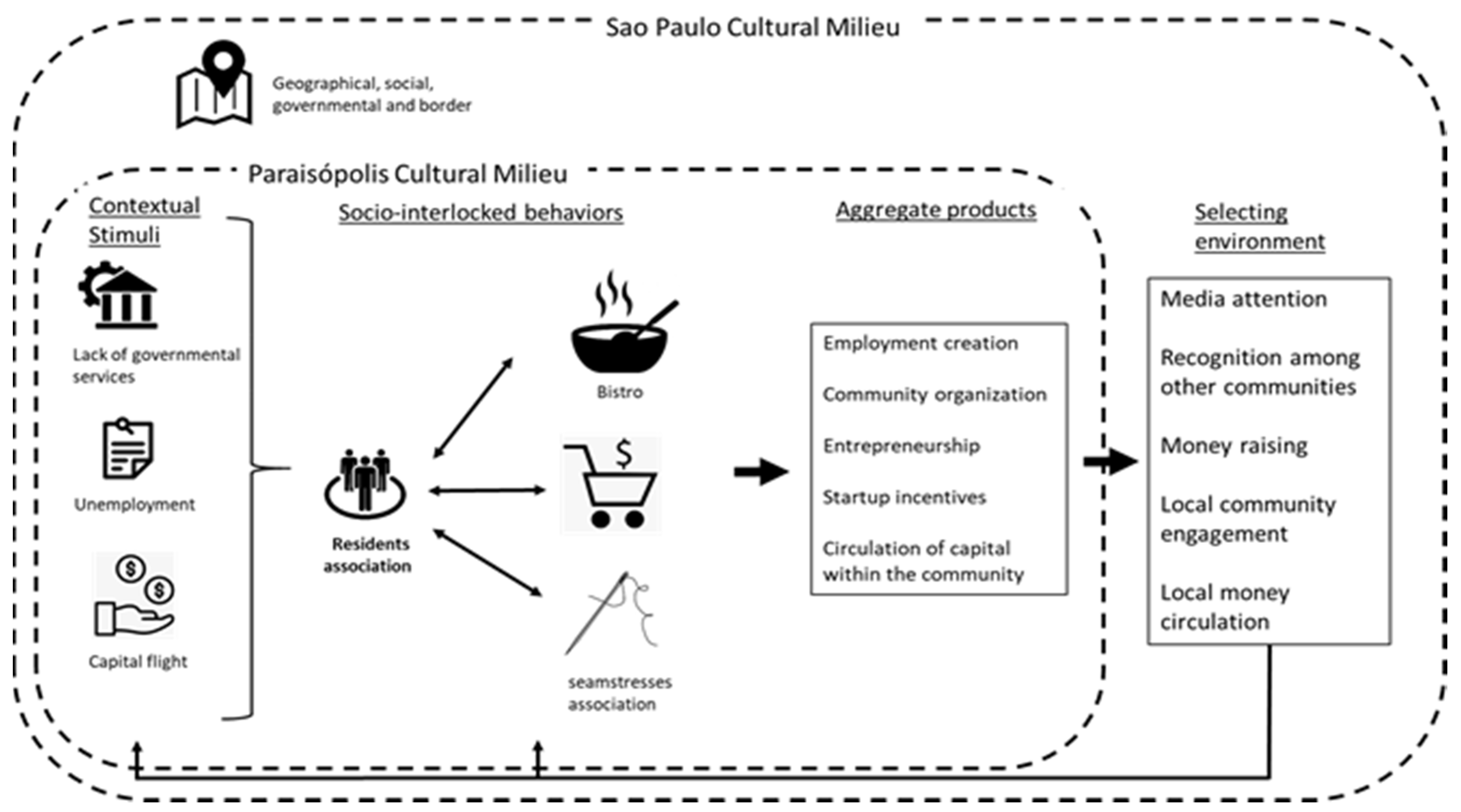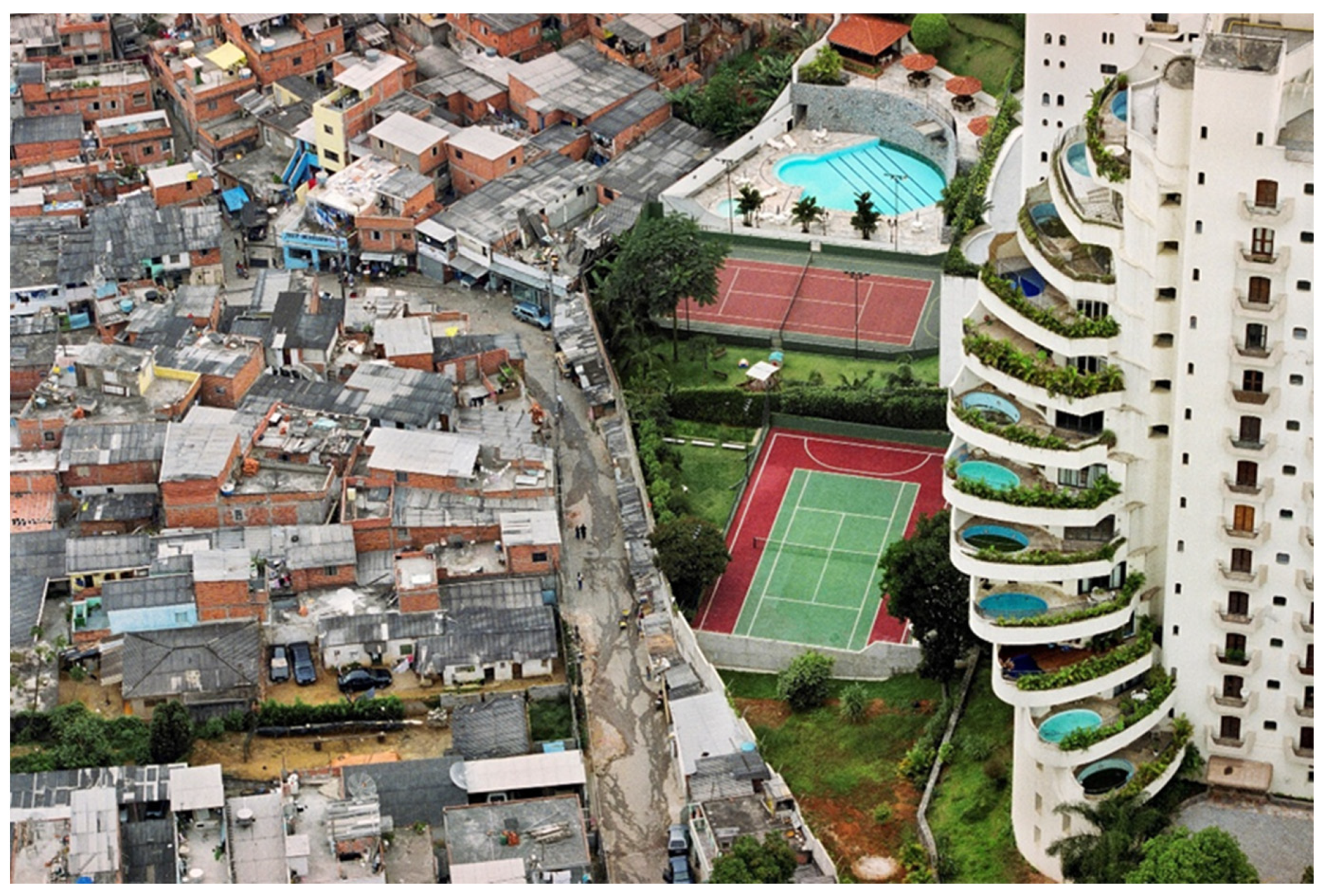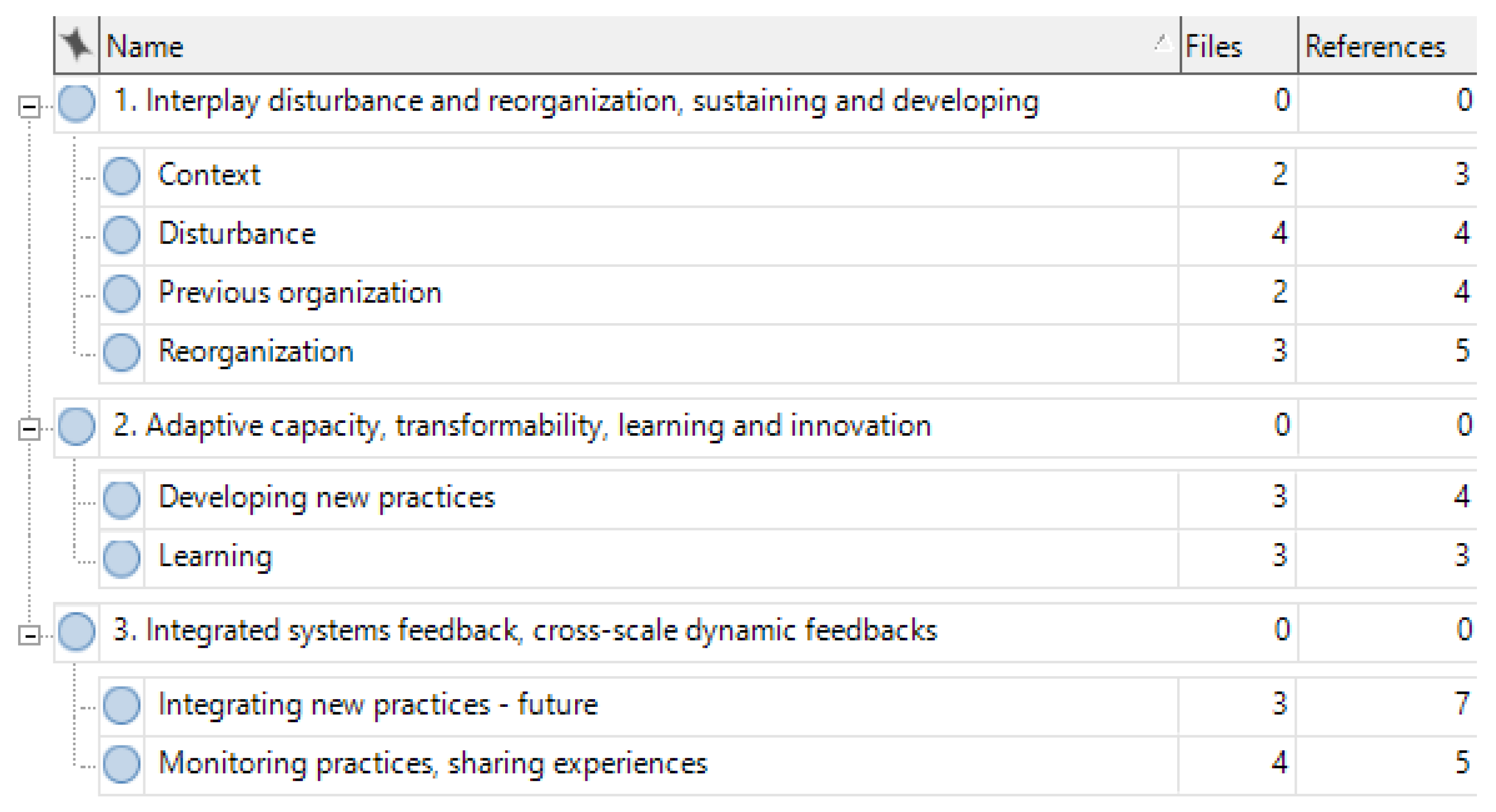A Behavioral Perspective on Community Resilience during the COVID-19 Pandemic: The Case of Paraisópolis in São Paulo, Brazil
Abstract
1. Introduction
2. Community Resilience: Complex Systems and Metacontingencies
2.1. Community Resilience and the COVID-19 Pandemic
2.2. Complex Systems and Metacontingencies
3. Settings: Paraisópolis Cultural Milieu
3.1. Ecological Boundary
3.2. Geographic Boundary
3.3. Psychological Boundary
3.4. Web of Interlocking Metacontingencies in Paraisópolis
4. Methods
4.1. Data Gathering
4.1.1. Access to the Community and Participants
4.1.2. Interviews
- Characteristics: interplay disturbance and reorganization, sustaining and developing;
- Focus: adaptive capacity, transformability, learning and innovation;
- Context: integrated systems feedback and cross-scale dynamic feedback.
4.2. Analysis and Ethics
5. Results
5.1. Characteristics: Interplay Disturbance and Reorganization, Sustaining and Developing
5.2. Focus: Adaptive Capacity, Transformability, Learning and Innovation
5.3. Context: Integrated Systems Feedback, Cross-Scale Dynamic Feedbacks
6. Discussion
7. Conclusions
Author Contributions
Funding
Institutional Review Board Statement
Informed Consent Statement
Data Availability Statement
Acknowledgments
Conflicts of Interest
Appendix A. Interview Guide
- Characteristics: Interplay disturbance and reorganization, sustaining and developing;
- When was the moment that you became aware that the pandemic would reach Paraisópolis?
- What kind of previous organizations facilitated new practices?
- Focus: Adaptive capacity, transformability, learning and innovation;
- 3.
- What have you learned during the pandemic?
- 4.
- How were the different strategies towards that containing the pandemic created?
- 5.
- How was movement of the street presidents created? How is your experience with this movement?
- Context: Integrated systems feedback and cross-scale dynamic feedback.
- 6.
- How are results monitored?
- 7.
- How is the communication between street presidents and the residents’ association?
- 8.
- What challenges do you identify at this point?
- 9.
- From your experience, what may be kept maintained from this period after the pandemic?
- 10.
- Is there anything you would to like to add?
References
- Cohen, J.; Kupferschmidt, K. Countries test tactics in ‘war’ against COVID-19. Science 2020, 367, 1287–1888. [Google Scholar] [CrossRef] [PubMed]
- Axelrod, R.; Cohen, M.D. Harnessing Complexity; Basic Books: New York, NY, USA, 2000. [Google Scholar]
- Corburn, J.; Vlahov, D.; Mberu, B.; Riley, L.; Caiaffa, W.T.; Rashid, S.F.; Ko, A.; Patel, S.; Jukur, S.; Martinez-Herrera, E.; et al. Slum health: Arresting COVID-19 and improving well-being in urban informal settlements. J. Urban Health 2020, 97, 1–10. [Google Scholar] [CrossRef] [PubMed]
- Scott, J.C. Seeing Like a State: How Certain Schemes to Improve the Human Condition Have Failed; Yale University Press: New Haven, CT, USA, 1998. [Google Scholar]
- Mamelund, S.-E. Social inequality—A forgotten factor in pandemic influenza preparedness. Tidsskr. Den Nor. Legeforening 2017, 137, 911–913. [Google Scholar] [CrossRef] [PubMed]
- Tampe, T. Potential impacts of COVID-19 in urban slums: Addressing challenges to protect the world’s most vulnerable. Cities Health 2020. [Google Scholar] [CrossRef]
- Lopes, M. Brazil’s Favelas, Neglected by the Government, Organize Their Own Coronavirus Fight. Available online: https://www.washingtonpost.com/world/the_americas/coronavirus-brazil-favela-sao-paulo-rio-janeiro-bolsonaro/2020/06/09/8b03eee0-aa74-11ea-9063-e69bd6520940_story.html (accessed on 10 July 2020).
- Instituto Pólis. Paraisópolis Tem Melhor Controle da Pandemia do que o Município de São Paulo. Available online: https://agenciagalo.com/wp-content/uploads/2020/06/Release-P%C3%B3lis-Parais%C3%B3polis.pdf (accessed on 10 August 2020).
- Instituto Pólis. Mortes Por Covid-19 Crescem 240% em Paraisópolis em Dois Meses. Available online: https://www.capitolio.com.br/noticias/2020/09/08/mortes-por-covid-19-em-paraisopolis-crescem-240-em-dois-meses/ (accessed on 10 October 2020).
- Malott, M.; Glenn, S. Targets of intervention in cultural and behavioral change. Behav. Soc. Issues 2019, 15, 31–57. [Google Scholar] [CrossRef]
- Borba, A. The selection of different interlocked behavioral contingencies and maintenance of common pool resources: The case of the production of açaí berries. Behav. Soc. Issues 2019, 28, 229–247. [Google Scholar] [CrossRef]
- Couto, K.; Lorenzo, F.; Tagliabue, M.; Henriques, M.; Lemos, R. Underlying principles of a Covid-19 behavioral vaccine for sustainable cultural change. Int. J. Env. Res. Public Health 2020, 17, 9066. [Google Scholar] [CrossRef] [PubMed]
- Van Bavel, J.; Baicker, K.; Boggio, P.; Capraro, V.; Cichoka, A.; Cikara, M.; Crockett, M.; Crum, A.; Douglas, K.; Druckman, J.; et al. Using social and behavioral science to support Covid-19 pandemic response. Nat. Hum. Behav. 2020, 4, 460–471. [Google Scholar] [CrossRef] [PubMed]
- Tibério, S.; Mizael, T.; Luiz, F.; Rocha, C.; Araújo, S.; dos Santos, A.; Terhoch, G.; Guarnieri, L.; Fonseca Júnior, A.; Hunziker, M. A natureza comportamental da pandemia de Covid-19. Rev. Bras. Análise Comp. 2020, 16, 57–70. [Google Scholar] [CrossRef]
- Camargo, J.; Calixto, F. Combatendo a tragégia dos comuns: Como estratégias para autocontrole de cooperação social podem contribuir para o enfrentamento da pandemia de Covid-19. Rev. Bras. Análise Comp. 2020, 16, 71–83. [Google Scholar]
- Amorim, V.C.; Guimarães, T.M.M.; de Almeida, J.A.T.; Vanderlon, Y.; & Abdala, M. Promoção de isolamento social na pandemia de covid-19: Considerações de análise comportamental da cultural. Rev. Bras. Análise Comp. 2020, 16, 31–40. [Google Scholar] [CrossRef]
- Carpenter, S.; Walker, B.; Anderies, J.M.; Abel, N. From metaphor to measurement: Resilience of what to what? Ecosystems 2001, 4, 765–781. [Google Scholar] [CrossRef]
- Folke, C. Resilience: The emergence of a perspective for social–ecological systems analyses. Glob. Environ. Chang. 2006, 16, 253–267. [Google Scholar] [CrossRef]
- Holland, J.H. Hidden Order How Adaptation Builds Complexity; Addison-Wesley: Reading, PA, USA, 1995. [Google Scholar]
- Houmanfar, R.; Rodrigues, N.J.; Ward, T.A. Emergence and metacontingency: Points of contact and departure. Behav. Soc. Issues 2010, 19, 53–78. [Google Scholar] [CrossRef]
- Sandaker, I. A selectionist perspective on systemic and behavioral change in organizations. J. Organ. Behav. Manag. 2009, 29, 276–293. [Google Scholar] [CrossRef]
- Sánchez, J.G.A.; Houmanfar, R.A.; Alavosius, M.P. A Descriptive Analysis of the Effects of Weather Disasters on Community Resilience. Behav. Soc. Issues 2019, 28, 298–315. [Google Scholar] [CrossRef]
- Kaliou, M.; van de Lindt, J.; McAllister, T.; Ellingwood, B.; Dillard, M.; Cutler, H. State of the research in community resilience: Progress and challenges. Sustain. Resilient Infrastruct. 2018, 5, 131–151. [Google Scholar] [CrossRef]
- Nguyen, H.; Akerkar, R. Modelling, measuring and visualizing community resilience: A systematic review. Sustainability 2020, 12, 7896. [Google Scholar] [CrossRef]
- Cohen, O.; Leykin, D.; Lahad, M.; Goldberg, A.; Aharonson-Daniel, L. The conjoint of community resilience assessment measure as a baseline for profiling and predicting community resilience for emergencies. Technol. Forecast. Soc. Chang. 2013, 80, 1732–1741. [Google Scholar] [CrossRef]
- Cohen, O.; Goldberg, A.; Lahad, M.; Aharonson-Daniel, L. Building resilience: The relationship between information provided by municipal authorities during emergency situations and community resilience. Technol. Forecast. Soc. Chang. 2017, 121, 119–125. [Google Scholar] [CrossRef]
- Pfefferbaum, B.; Pfefferbaum, R.; Van Horn, R. Community resilience interventions: Participatory, assessment-based, action-oriented processes. Am. Behav. Sci. 2015, 59, 238–253. [Google Scholar] [CrossRef]
- Houston, J. Boucing forward: Assessing advances in community resilience assessment, intervention, and theory to guide future work. Am. Behav. Sci. 2015, 59, 175–180. [Google Scholar] [CrossRef]
- Aldrich, D.; Meyer, M. Social capital and community resilience. Am. Behav. Sci. 2015, 59, 254–269. [Google Scholar] [CrossRef]
- Fransen, J.; Peralta, D.; Vanelli, F.; Edelenbos, J.; Olvera, B. The emergence of community resilience initiative during the Covid-19 pandemic: An international exploratory study. Eur. J. Dev. Res. 2020, 1–23. [Google Scholar] [CrossRef]
- Xu, W.; Xiang, L.; Proverbs, D.; Xiong, S. The influence of Covid-19 on community resilience. Int. J. Environ. Res. Public Health 2021, 18, 88. [Google Scholar] [CrossRef] [PubMed]
- Holland, J.H. Complex adaptive systems. Daedalus 1992, 121, 17–30. [Google Scholar]
- Skinner, B.F. Operant behavior. Am. Psychol. 1963, 18, 503–515. [Google Scholar] [CrossRef]
- Ferster, C.B.; Skinner, B.F. Schedules of reinforcement. Am. J. Psychol. 1959, 72, 320. [Google Scholar] [CrossRef]
- Glenn, S.S. Metacontingencies in walden two. Behav. Anal. Soc. Action 1986, 5, 2–8. [Google Scholar] [CrossRef]
- Krispin, J. Positive feedback loops of metacontingencies: A new conceptualization of cultural-level selection. Behav. Soc. Issues 1997, 26, 95–110. [Google Scholar] [CrossRef]
- Folke, C.; Carpenter, S.R.; Walker, B.; Scheffer, M.; Chapin, T.; Rockström, J. Resilience thinking: Integrating resilience, adaptability, and transformability. Ecol. Soc. 2010, 15, 20. [Google Scholar] [CrossRef]
- Wan, K.M.; Ho, L.K.K.; Wong, N.W.; Chiu, A. Fighting COVID-19 in Hong Kong: The effects of community and social mobilization. World Dev. 2020, 134, 105055. [Google Scholar] [CrossRef] [PubMed]
- Rowling, M. COVID-19: How Past Crises are Helping the World’s Cities to Respond and Rebuild. Available online: https://www.weforum.org/agenda/2020/05/cities-pandemic-coronavirus-covid19-health-response-response-rebuild/ (accessed on 10 July 2020).
- Holling, C.S. Resilience and stability of ecological systems. Annu. Rev. Ecol. Syst. 1973, 4, 1–23. [Google Scholar] [CrossRef]
- Berkes, F. Environmental governance for the Anthropocene? Social-ecological systems, resilience, and collaborative learning. Sustainability 2017, 9, 1232. [Google Scholar] [CrossRef]
- Olsson, P.; Folke, C.; Berkes, F. Adaptive comanagement for building resilience in social–ecological systems. Environ. Manag. 2004, 34, 75–90. [Google Scholar] [CrossRef]
- Folke, C.; Hahn, T.; Olsson, P.; Norberg, J. Adaptive governance of social-ecological systems. Ann. Rev. Environ. Resour. 2005, 30, 441–473. [Google Scholar] [CrossRef]
- Peters, D.P.; Bestelmeyer, B.T.; Turner, M.G. Cross–scale interactions and changing pattern–process relationships: Consequences for system dynamics. Ecosystems 2007, 10, 790–796. [Google Scholar] [CrossRef]
- Levin, S.A. Ecosystems and the biosphere as complex adaptive systems. Ecosystems 1998, 1, 431–436. [Google Scholar] [CrossRef]
- Heylighen, F. The science of self-organization and adaptivity. Encycl. Life Sup. Syst. 2001, 5, 253–280. [Google Scholar]
- Duchek, S. Organizational resilience: A capability-based conceptualization. Bus. Res. 2020, 13, 215–246. [Google Scholar] [CrossRef]
- Kantor, J.R. Cultural Psychology, 1st ed.; Principia Press: Chicago, IL, USA, 1982. [Google Scholar]
- Center for Systems Science and Engineering—Johns Hopkins University. Coronavirus Resource Center. Available online: https://coronavirus.jhu.edu/map.html (accessed on 30 November 2020).
- IBGE. Grade Estatística e o Atlas Digital Brasil 1 Por 1. Available online: https://www.ibge.gov.br/geociencias/atlas/tematicos/24684-atlas-digital-brasil-1-por-1.html?=&t=downloads (accessed on 25 October 2020).
- Vieira, T. Paraisópolis. Available online: https://www.tucavieira.com.br/paraisopolis (accessed on 20 October 2020).
- Rede Nossa São Paulo. Mapa da Desigualdade 2019. Available online: https://www.nossasaopaulo.org.br/2019/11/05/mapa-da-desigualdade-2019-e-lancado-em-sao-paulo/ (accessed on 1 October 2020).
- Ajzenman, N.; Cavalcanti, T.; Da Mata, D. More than words: Leaders’ speech and risky behavior during a pandemic. Soc. Sci. Res. Netw. 2020, 3582908. [Google Scholar] [CrossRef]
- Roubaud, F.; Razafindrakoto, M.; Saboia, J.; Castilho, M.; Pero, V. The Municipios Facing COVID-19 in Brazil: Socioeconomic Vulnerabilities, Transmisssion Mechanisms and Public Policies (No. DT/2020/12). Available online: https://www.ie.ufrj.br/images/IE/TDS/2020/TD_IE_032_2020_ROUBAUD_et%20al.pdf (accessed on 20 November 2020).
- Cruz, C.H.D.B. Social distancing in São Paulo State: Demonstrating the reduction in cases using time series analysis of deaths due to COVID-19. Rev. Bras. Epidemiol. 2020, 23, e200056. [Google Scholar] [CrossRef] [PubMed]
- State of São Paulo. Adesão ao Isolamento Social em São Paulo. Available online: https://www.saopaulo.sp.gov.br/coronavirus/isolamento/ (accessed on 20 November 2020).
- Merriam, S. Introduction to qualitative research. In Qualitative Research in Practice. Examples for Discussion and Analysis, 1st ed.; Merriam, S.B., Ed.; Jossey-Bass: San Francisco, CA, USA, 2002; pp. 3–17. [Google Scholar]
- de Carvalho, L.C.; Sandaker, I.; Ree, G. An ethnographic study of tagging cultures. Behav. Soc. Issues 2017, 26, 67–94. [Google Scholar] [CrossRef]
- Tsoukas, H.; Hatch, M.J. Complex thinking, complex practice: The case for a narrative approach to organizational complexity. Hum. Relat. 2001, 54, 979–1013. [Google Scholar] [CrossRef]
- Gibbs, G.R. Qualitative Data Analysis: Explorations with NVivo, 1st ed.; Open University: Philadelphia, PA, USA, 2002. [Google Scholar]
- Norman, J.; Bar-Yam, Y.; Taleb, N.N. Systemic Risk of Pandemic via Novel Pathogens—Coronavirus: A Note. New England Complex Systems Institute. Available online: https://necsi.edu/systemic-risk-of-pandemic-via-novel-pathogens-coronavirus-a-note (accessed on 7 December 2020).




| Codes | Extracts From Interviews |
|---|---|
| Context | “Paraisópolis has always struggled with the absence of the state. If the rich population would struggle with the restricted number of ventilators and possibly with the collapse of the health sector, imagine people in our community who would not be able to follow the recommendations from World Health Organization. We have large families living in small households” (Community leader A) |
| Previous Organization | “We had never experienced a pandemic before, but we have eighty years of experience in demanding public policies related to wastewater and urbanization. (…) Paraisópolis was already seen as a model in terms of implementation of social projects and social entrepreneurship. We already had thirty-six social projects, including areas such as arts and sports” (Community leader B) |
| Disturbance | “We had access to news and research regarding the very fast spread of the virus in other countries. We started to think about it before the virus arrived in Brazil” (Community leader B) |
| Reorganization | “We realized that we could lose contact with the population during the pandemic and therefore we needed to have more community leaders. This is the principle behind the idea of the street presidents.” (Community leader A) “We developed a new management model in partnership with the G10. We already had projects such as ‘Sewing Dreams’ and the bistro “Mãos de Maria,” which was mainly focused on women who had suffered violence and capacitation. We thought about how we could use that in the context of the pandemics and economic crisis. ‘Sewing Dreams’ started producing masks. The bistro started packed lunches to be distributed to the population” (Community leader B) |
| Codes | Extracts From Interview |
|---|---|
| New practices | “We created the movement of the street presidents and a web of solidarity and which the residents help each other. Each president is responsible for fifty families making sure they stay home, delivering donations and ordering medical help when necessary. We created three fronts: Health, social, and medical” (Community leader A) “In one of our meetings, someone mentioned a case when people self-organized in the context of Spanish Flu. Then we discussed what we could do here in Paraisópolis and how we could use our organization and the residents in the context of the pandemics (…). It was very difficult in the beginning… this is cultural… the people did not have the habit of helping each other. Now we became clear that we need to help each other to cope with the situation” (Community leader B) |
| Learning | “I’ve learned a lot in terms of helping and seeing the needs of the next. I thought I lived in poverty but there is people living in worse conditions. I have lived for ten years in this community, but I had not seen so many stories as now during the pandemic. It is a crazy experience” (Street president A) |
| Codes | Extracts From Interview |
|---|---|
| Monitoring results | “We have a group of coordinators responsible for monitoring the activity of street presidents in each geographical area and listen to their demands. Then we have a weekly general meeting in which we discuss problems identified in the community and solutions. The decision and communication process happens in such meetings and through WhatsApp” (Community leader A) “Community leader A provides us with information regarding donations and asks us how our work is going” (Street president B) |
| Integrating new practices | “The organization of the street presidents will be kept and they will contribute to the creation of the new Paraisópolis that we dream of, the favela transformed in a neighborhood (…) We need to make the government more sensitive to the need of new public policies. The whole society is talking about a new normal post-pandemic, but the truth is that the favelas are still struggling to have their ‘normal’. It is not normal that the ambulance doesn’t drive here. It is not normal that people die over a brook. It is not normal to have water shortages. It is not normal to have a rising unemployment. It is not normal that people starve” (Community leader A) “We will keep the street president in the post-pandemic. They will be able to keep their work without us telling them what they have to do, monitoring their areas before we can come with our action” (Community leader B) “I don’t know how it will be when the pandemic is gone but if it wasn’t because of the street presidents we wouldn’t be able to do this incredible work. This can be kept. I think it will be useful in the future” (Street president B) |
Publisher’s Note: MDPI stays neutral with regard to jurisdictional claims in published maps and institutional affiliations. |
© 2021 by the authors. Licensee MDPI, Basel, Switzerland. This article is an open access article distributed under the terms and conditions of the Creative Commons Attribution (CC BY) license (http://creativecommons.org/licenses/by/4.0/).
Share and Cite
Bento, F.; Couto, K.C. A Behavioral Perspective on Community Resilience during the COVID-19 Pandemic: The Case of Paraisópolis in São Paulo, Brazil. Sustainability 2021, 13, 1447. https://doi.org/10.3390/su13031447
Bento F, Couto KC. A Behavioral Perspective on Community Resilience during the COVID-19 Pandemic: The Case of Paraisópolis in São Paulo, Brazil. Sustainability. 2021; 13(3):1447. https://doi.org/10.3390/su13031447
Chicago/Turabian StyleBento, Fabio, and Kalliu Carvalho Couto. 2021. "A Behavioral Perspective on Community Resilience during the COVID-19 Pandemic: The Case of Paraisópolis in São Paulo, Brazil" Sustainability 13, no. 3: 1447. https://doi.org/10.3390/su13031447
APA StyleBento, F., & Couto, K. C. (2021). A Behavioral Perspective on Community Resilience during the COVID-19 Pandemic: The Case of Paraisópolis in São Paulo, Brazil. Sustainability, 13(3), 1447. https://doi.org/10.3390/su13031447






